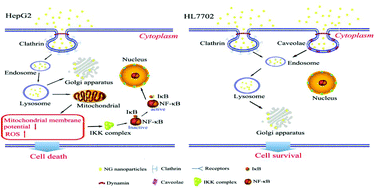Selective killing of hepatocellular carcinoma HepG2 cells by three-dimensional nanographene nanoparticles based on triptycene†
Abstract
Carbon-based materials have been widely used in the biomedical fields including drug delivery and cancer therapies. In this paper, a recently synthesized three-dimensional nanographene (NG) based on triptycene self-assembles into nanoparticles which selectively kill human hepatocellular carcinoma HepG2 cells as compared to human normal liver HL7702 cells. Obvious differences in cellular accumulation, the endocytic pathway and intracellular trafficking of NG nanoparticles are observed in HepG2 cells and HL7702 cells. Further studies reveal that NG nanoparticles significantly increase the levels of reactive oxygen species (ROS) in HepG2 cells, but not in HL7702 cells. NG nanoparticle-induced ROS result in apoptosis induction and the decrease in mitochondrial membrane potential in HepG2 cells. Moreover, IKK/nuclear factor-κB (NF-κB) signaling is found to be activated by NG nanoparticle-induced ROS and serves to antagonize NG nanoparticle-induced apoptosis in HepG2 cells. Our studies show that the distinct behaviors of cellular uptake and ROS-mediated cytotoxicity are responsible for the selective killing of HepG2 cells. This study provides a foundation for understanding the mechanism of selective induction of apoptosis in cancer cells by NG nanoparticles and designing more effective chemotherapeutical agents.


 Please wait while we load your content...
Please wait while we load your content...